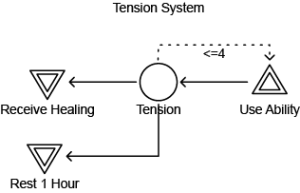Pathfinder RPG has several character classes with resource pools. However, nearly all of them function as static engines, giving a simple pool of points that replenish daily. Really, this is a missed opportunity. As I illustrated when comparing ki and grit, a game designer can use a resource pool to influence how a class “feels” when played. When designing the artiforged base class, I couldn’t resist putting this into practice. Thus, I created a resource system called the tension mechanic.

Machination diagram of the Tension Mechanic
How Tension Works
An artiforged begins play with zero tension. Some artiforged abilities raise his tension similar to abilities in other classes costing pool points. If the artiforged exceeds his maximum tension, the he becomes fatigued and unable to use tension abilities. Tension lowers hourly or whenever the artiforged receives healing from a cure spell or the cleric’s channel energy class feature.
Gameplay Consequences
As I explained when contrasting ki and grit, the method of resource generation proves vital to creating a dynamic engine. Tying tension removal to healing has a number of consequences in shaping how the class plays out.
- The tension mechanic encourages risky play. Tying tension removal to healing creates a play pattern where players play aggressively, use abilities, take damage, and heal while removing tension. When playtesting the artiforged, I felt free to use my powerful abilities in the heat of combat, knowing that I will lose tension when my hit points get restored.
- Tension encourages teamwork. Though he can use wands with the Use Magic Device skill, the artiforged cannot cast healing spells. This new dependency on healing creates an interesting dynamic between the artiforged and allies who can cast healing spells. A healer ally not only can keep the artiforged alive, but also help him become a better fighter. During playtests, the witch in my friend’s game said he enjoyed being my “pocket medic” as a result.
- Tension helps balance melee artiforged versus ranged artiforged. Ranged fighters are among the strongest builds in Pathfinder. Since melee artiforged will likely take more damage, they will have more opportunities to remove tension and therefore can use abilities more frequently than ranged artiforged.
- Tension removal has diminishing returns. Only non-cantrip spells, spell-like abilities, and channel energy can remove tension. All of these require expending consumable items or limited use class features. As a result, it’s not optimal for an artiforged to use these resources while not injured.
Tension does have an antipattern where a PC must get harmed to optimally regain their resources. However, the tension mechanic does prove successful in encouraging teamwork and fun, risky play.